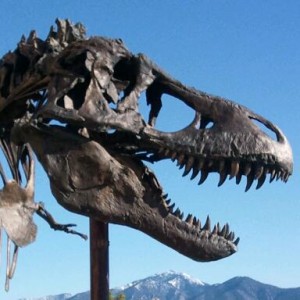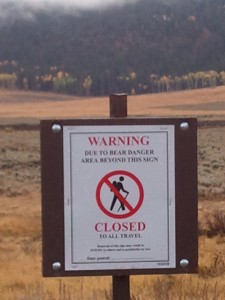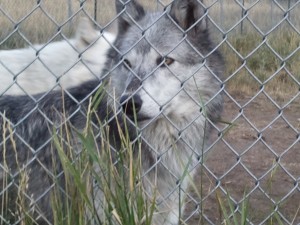For audio version click here: bearsandwolves48
Ten of us saw the first grizzly walking the bed of the Lamar River. He came to the sharp cut of the bank, and looking like a big boy climbing into a kitchen chair, he placed both front paws on the edge, hitched up his right leg to the top, leapt up with impressive ease and agility and moved along the right side of the river, his head sniffing the ground, then looking at us, then sniffing the air. We watched him for 10 minutes before we lost him in the pines at the edge of the foothills.
We saw the second grizzly while looking for wolves. He came over a small rise only 200 feet away and froze us in place. His coat was almost black, but there was no mistaking the hump over the shoulder, the short snout, the beetle brow. This one was bigger, very light on his feet and was almost trotting. He seemed purposeful. He ignored us. Within two minutes he disappeared into a ravine in the direction of Hell-Roaring Creek gorge. The morning temperature in the Park was already in the 20’s and 30’s and bears were eating as much as they could before denning for the winter.
Even in a group and therefore safe, these bears sent a clean, sharp zing of apprehension through us. No one spoke. Their jaws are powerful enough to crack open the thick femurs of buffalo. Watching him, I thought of Patti and me alone at the bridge over Hell-Roaring Creek a few days before.
Our experience with wolves had begun in the previous three days at a wolf sanctuary outside of Bozeman.
Mary and Chris bought the Howlers Inn* because they wanted a new path in life for themselves and their daughters. They knew they were also buying a wolf sanctuary. Its four acres are divided into two enclosures and are home to two packs, a total of eight wolves. Chest high grass, boulders and thickets fill up both. Both packs have dug dens in the thickets.
The three oldest wolves came with the Inn. They took in five others from overly large litters from photography game farms. Those pups probably would have been destroyed if not for Howlers Inn. None of their wolves has ever lived in the wild. They will not accept wild wolves. They had bottle-fed the other five as puppies and in the transition phase of moving them into the second pack, often allowed them in the house until their noses touched the counter tops. They are neutered at three weeks. Wolves cannot be housebroken nor taught commands.
Chris and Mary have done the deep research necessary to make wise decisions. They are always aware that their wolves are wild. They are not pets. One of their cats climbed the 10 foot chain link fence. No more cat. The previous owner’s dog, out of either a desire to make friends or affirm his territory, tried to dig his way into the enclosure. They tore his leg off.
The only entrance gate is padlocked. Only Chris and Mary may enter. They do not interfere in pack politics. They do not take food away. All fresh meat or road-kill is tossed over the fence. Still, the pack of five, the bottle-fed pack, have accepted the family as pack mates.
Patti and I watched Mary with them one evening. All five of the wolves in this second pack swirled around her affectionately. Some collapsed onto their backs for belly rubs. Comanche, a big white wolf, the alpha, put his paws on her shoulders and towering over Mary, gave her kisses.
Their size is deceptive. They easily disappear into the waist high grass, but at the fence, they are enormous. Mary encouraged us to scratch Comanche’s back through the fence. He licked our hands. From the tip of his nose to the base of his tail, he was 5 1/2 feet long. His head rested even with my navel. His chest and belly were muscled, as firm and thick around as a barrel. He weighs 140 pounds.
The bronze replica of the Tyrannosaurus Rex found and excavated by the staff at the Museum of the Rockies seems tensed in the sun, jaws gaping, in pride of place at its entrance. Named `Big Mike’ by the museum staff, it calls to mind the sense of awe and desire for intimacy we reserve for big predators, no matter their place in time. They are the great stars of the animal world, able to command an operatic sense of drama. We love their actions; they are conduits of a prickly, ever alert energy that is common to wild places. How could a T-Rex ever be boring? We have a pretty good idea what elk and buffalo will do – graze, but grizzlies will hunt and wolves must hunt. What will they do next we wonder.
In the wild, wolves regularly take down bull elk the size of horses and will even go after buffalo that outweigh them by a factor of 20 to 1. They can eat 20 pounds of meat in 20 minutes; they ‘wolf it down`. They will give their lives to protect their pups, even taking on and intimidating grizzlies.
Brad Bulin, a wildlife biologist who works for The Yellowstone Association, told us grizzlies will actively hunt baby elk calves. On one of his classes’ observation stops he saw a grizzly run down a calf and tear it apart in front of dozens of horrified, fascinated observers. We cannot watch. We cannot turn away for fear of missing something rare. Predators leave us continually asking the ancient question true of all narratives: then what happened? Their existence creates stories precisely because they must kill.
Most of us don’t want to physically possess predators, not like Terry Thompson in Zanesville, Ohio whose obsession led directly to the deaths of dozens of tigers, bears and wolves. Instead, perhaps akin to ancient shamans whose paintings of beasts adorn the walls of caves in France and Spain, we want to assert that their essence carries the powerful enchantment inherent in creatures who can look at us as equals and occasionally, prey. We want to pass our stories along to others of our encounters with them, of the authority of their indifferent gaze, of the sense that as we walked trails, they could have been watching us … deciding … what will happen next.
*Go to www.howlersinn.com for photos of all the wolves.


